A SWEET HISTORY OF THE NEW JERSEY HONEY BEE BUSINESS
Bee Keeping Event Explores Region's Most Important Insect Trade
By Hoag Levins

CAMDEN, N.J. -- It was a sight to behold in an era when many believe children have little interest in anything except electronic screens and blinking, buzzing push buttons.

Photo: Hoag Levins
|
| New Jersey state bee inspector Paul Raybold with his 'observation bee hive' at yesterday's Camden County Historical Society event. Larger photo. | Five youngsters, three of them in cub scout uniforms, moved in desultory fashion along the ground floor of the Camden County Historical Society's Museum. They moped past the Civil War posters and uniforms, the Victorian glass exhibit, and the counters full of Lenape arrowheads and war clubs.
Box of bees
Then suddenly, they stopped in their tracks at a small fold-up table exhibit that offered only a glass-sided wooden box full of living bees. Two of the boys craned their heads close-in to the glass, as if in disbelief. A girl pushed her finger at the captive insects and squealed. The group soon began to move on, but then stopped and came back to lean on their elbows and watch the wooden box for the better part of half an hour.
Nearby, a quiet-spoken man holding a few odd tools explained how, in a bee hive, 40,000 to 60,000 insects of three different kinds behave in such an industrious and tightly coordinated manner that their nest functions as a single living organism.
'Where's the queen?'
"The question kids ask most is, 'Where is the queen?'," said Paul Raybold, tapping on the observation hive. "And she's in there. We've found her and pointed her
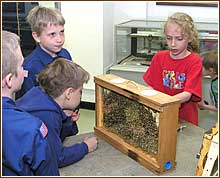
Photo: Hoag Levins
|
| Children and adults clustered around the observation hive all afternoon. The glass-walled container held more than 2,000 living bees. Larger photo. | out and the kids seem enthralled to look at something they have always heard about but never actually saw before." He emphasized his words by further tapping with his hive tool -- a shiny, chisel-like implement used for a variety of beekeeper tasks such as prying out a hive's slats of honey combs.
Raybold is the New Jersey state apiarist -- the top official and inspector of all things related to bees. A 24-year-veteran of the Division of Plant Industry of the New Jersey Department of Agriculture, he has also been a beekeeper since he was 12 years old. At times he speaks of the insects in the almost-tender way others might speak of their beloved family dog or even their children.
A resident of Phillipsburg in Warren County, he travels the state constantly, inspecting bee hives and meeting with beekeepers and the industrial and municipal officials who become involved in bee issues.
18th-Century skills
Yesterday, he came to the Camden County Historical Society as part of the annual program that demonstrates the historic realities, crafts and artifacts that were an integral part of the lives of local 18th-century residents. In its sixth year, the one-day event highlighted the history and business of beekeeping; the recruitment, training and equipping of Revolutionary War militia; the lore of local Lenape Indians; open-hearth cooking; traditional
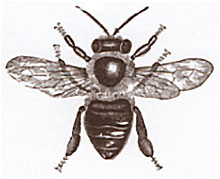
|
| An early 19th-century illustration of a worker honey bee. | music; and the sheep-to-shawl cycle of manual textile production (see photo page links at top of this article).
Raybold's honey bee exhibit, though small, was the most atttention getting. The two-foot-long, four-inch-wide observation hive held more than 2,000 bees engaged in the frenzy of endless movement that is their trademark behavior.
Raybold said the business of beekeeping is not as large as it once was back when New Jersey was a sprawl of farmlands, rather than housing developments and strip mall parking lots. However, the number of beekeepers is slowing rising again. He estimated that about 2,500 people maintain a total of about 6,000 honey bee hives throughout the state. Two weeks ago when it held its annual training course for wannabe beekeepers, 51 people attended.
He also noted that the New Jersey Beekeeper Association celebrated its 100th anniversary in 2002, and that the state has had an official bee inspector since 1915.
Historical cynics and bees
"When we announced this earlier in the year, a few cynics asked what bees had to do with a historical society," said Historical Society executive director Judith Snyder. "But beekeeping, the business of honey, and the production and export of beeswax is one of Camden County's oldest enterprises. It ties together the past, as it was lived right here in Pomona Hall on the Cooper plantation,
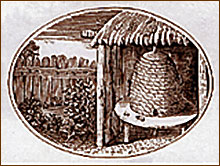
|
| Bee skeps made of straw were commonly used as hives in 18th-century Philadelphia and the neighboring riverside counties of New Jersey. | with the present, when bees
continue to play a critical role in local agriculture. Just watching the faces of the children gathered around that glass-walled observation hive today showed us just how rich an educational experience this really is."
And, indeed, as history goes in the Delaware Valley, the honey bee has created quite a buzz. Among other things, it is the official New Jersey insect and a major player in the very identity of the "Garden State."
Centuries ago, the native Lenape worked wild tree hives and so celebrated the honey season and its sweet summer prize that they called July "Jagatamoewi Gischuch," or "Honey Bee Month."
During the 1700s sweets were a rare and luxurious commodity for the European colonists. Sugar, which required large communities of slaves in tropical plantations to produce, was extremely expensive. Honey, however, was available to most Delaware Valley residents from wild hives found in the surrounding forests, although its collection required a certain amount of derring-do to avoid stings. And even then, the domestic beekeeping practices that had long been established in England and other parts of Europe continued to evolve in sophistication here.
By the time of the Revolution, local production
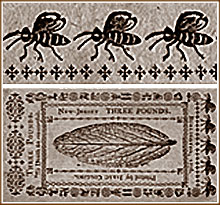
|
| Some 18th-century New Jersey currency included the image of the honey bee, which was an important element of daily life and commerce in the colony. Larger image. | of honey and bees wax were major local industries.
Bee currency
In fact, they were such an important part of the local economy that New Jersey currency circulating during the War featured honey bee images.
Ads and articles in Benjamin Franklin's Pennsylvania Gazette throughout the latter 1700s documented the role of bee-related products in everyday life and commerce. Just a ferry ride away across the Delaware, Philadelphia was the colonial era's largest and most prosperous city. Placed by some of the largest merchants, the newspaper's advertisements document a thriving business in which honey and beewax where valuable enough to serve as their own kind of currency.
For instance, in a routine Nov. 2, 1791 ad, the shop of George Meade on the Walnut Street Wharf announced that it had hogsheads of Madeira Wine, Irish Linens, Spermaceti Candles and Burlington Pork of prime quality that could be purchased with payments of, among other things, quantities of raw beeswax.
Similarly, Second and Front Street druggist George Hunter noted that his shop offered medicines, paints, brushes and dye stuffs that could be purchased by cash, Pennsylvania or Jersey State money or "bees wax."
Some sense of the volume of this bee-based business can be found in a period report to the Pennsylvania State Assembly. It indicated that during the single year 1773 a total of 64,546 pounds of beeswax was exported by Philadelphia merchants. And that only represented the amount shipped to other locations not the amounts that were cast into premium beeswax candles by local chandlers.
Bee hives were also an asset that increased the value of local properties. One 1757 ad placed by a public auctioneer selling the estate of a Deptford Township farmer listed

Photo: Hoag Levins
|
| Docent Shannon Lewis explains beeswax candle making in the 18th-century chandler craft exhibit of the Camden County Historical Society museum. Larger photo. | assets including "Wheat and Rye in the Sheaff, a large Quantity of good Hay, Cyder Casks, several Stocks of Bees, and a good Market Boat."
'Flocks of bees'
In another routine Oct. 20, 1790 ad, the Gazette detailed a ten-acre tract of plantation land for sale that, along with its dwelling house and barn, included "a valuable breeding mare, sheep, swine, several flocks of bees, houshold furniture, and farming utensils."
That same year's Town and Country Almanack offered for sale by Philadelphia printer Zachariah Poulson emphasized that it contained important advice for local farmers including "the making of good cyder, the raising of sheep, the preservation of bees and the trimming of fruit trees."
The larger importance of honey bees' direct involvement in the central biological mechanics of the crop cycle became better appreciated in the 1800s. In 1855, for instance, the Provincial Freeman, a newspaper published by freed American slaves living in Toronto and widely read by freed slaves who were farmers, reported that a Paris journal "states that bees greatly improved the fructification of fruit trees. Orchards in which several hives are kept, always produce more fruit than those in which there are none."
Today, the critical role of honey bees is intimately understood by anyone involved in local agriculture but not by the general public, which either takes the miracle of pollination for granted or never learned how it really works, said Raybold.
The process is simple. Honey bees visit flowers to collect
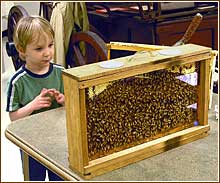
Photo: Hoag Levins
|
| Many visitors were mesmerized by the seething bees behind the glass. Larger photo. | the sugary nectar they produce. In doing so, the insects' hairy bodies trap the dusty pollen from the flowers' anthers and then transport that substance to fertilize or "pollinate" other flowers. Meanwhile, the bees internally process the watery nectar into dense honey, which they store in their hives as a communal food source.
$200 million
The state Department of Agriculture estimates that honey bee pollination is crucial to about $200 million worth of annual agricultural production ranging from the vast expanses of blueberry and canberry fields that carpet much of southern New Jersey to virtually every kind of flowering vegetable and fruit.
"Honey bees are the only form of commercially viable and controllable pollination for large growing areas like those we have here," said Raybold. "Most people in today's large cities and residential municipalities simply do not realize the need for honey bees on farms or even in their own backyard gardens."
"If all honey bees in New Jersey died or disappeared tomorrow," he said, "the effects would be catastrophic. Farming all over, but especially in the southern New Jersey area, would be crippled. We're talking about millions and millions of dollars in losses."
The prospect of such a biological calamity is not so speculative. In recent years, New Jersey has suffered a plague of bee-killing mite infestations. Wild honey bee populations throughout the state have become so depleted that a rental bee industry is now thriving, said Raybold.
Each summer, contractors from Florida and Virginia truck in colonies of bee hives that are positioned in areas of blueberry, cranberry and other large crop concentrations. After the pollination season is over, the bee colonies are returned to their distant home base to await the following year's rental season.
Misconception: dangerous bees
Raybold seemed particularly disturbed by what he perceived as a widespread misconception that bees are dangerous -- a belief that can cause suburban residents to kill the insects or lobby to change local regulations to outlaw the keeping of bee hives in populated areas.
"People should not confuse honey bees with wasps, yellow jackets or hornets that are really responsible for most of the stings that occur each year," he said. "It is very unlikely to be stung by a honey bee at a picnic or barbeque. They are not aggressive. They are not carnivorous like yellow jackets and wasps. You seldom find honey bees in the vicinity of picnics and barbeques because those are not the kind of environments in
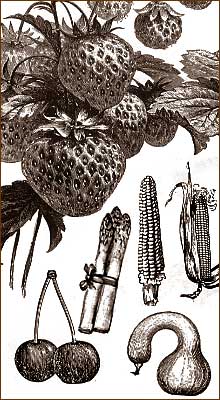
|
| The primary garden crops celebrated in 18th- and 19th-century illustrations -- such as corn, squash, carrots, pumpkins and stawberries -- could not grow without pollination by honey bees. | which they find their food source."
Historical importance
"The local importance of bees," said executive director Snyder, "hasn't changed in more than three hundred years. We know that without bees, the 18th-century's Joseph Cooper, of Cooper's Point, could not have grown the watermelon, asparagus and apple crops he documented. He, like his farming neighbors, was dependent on annual pollination by the swarms of tiny insects that facilitated such succulent plant life in his fields and orchards."
"In fact," she continued, "on a very basic level, one might even argue that bees were as crucial to the survival and development of early society in this county and the surrounding Delaware Valley as were things like horses, muskets, ferry boats and grist mills. Without healthy bee populations here, human inhabitants would have been without fundamental foodstuffs and economic staples like corn, squash, pumpkins and carrots."
"The story of the honey bee," she said, "is really the story of human agriculture -- and it hardly gets more historic than that."
All Rights Reserved © 2004, Hoag Levins
HoagL@earthlink.net
About this Web site
| 








